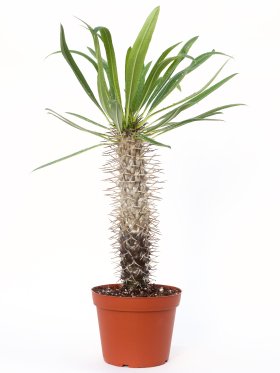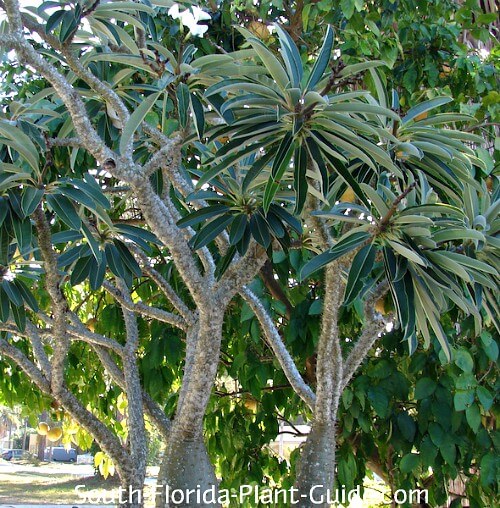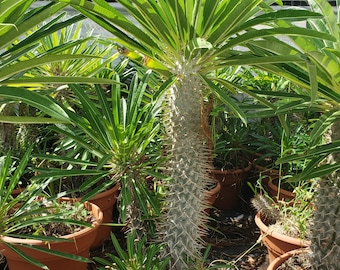
Source https://cactiandexotica.com/shop/pachypodium-lamerei
Plant Background
Even though the name refers the plant to as being a palm, that is not the case. The plant is actually a succulent that is from Madagascar and South Africa. As the picture shows, the trunk of the plant is a single spiny piece which leads up to an area full of leaves that resemble that of a palm. This is why the name suggests it being a palm tree.
The plant is in the family of Apocynaceae which commonly includes plants that have swollen bases. The name Pachypodium translates to mean “thick foot”, and this is refereeing to the thick swollen base of the succulent stem. The stem includes long spines for defense and has a toxic sap that is clear.
The plant is a perennial and is able to grow up to 15 feet tall and has a full leaf spread of almost 6 feet. The Madagascar Palm grows in full sunlight and produces a flower during the fall, spring, and summer seasons. It prefers drier climates and soil types and has a taproot for underground use.
Uses and Flowering

Source https://garden.org/plants/photo/375318/
The plant is often used indoors as a potted house plant as it has a very unique and artsy look to it. The plant requires low care and maintenance which makes it a really good plant for anyone looking to add beauty to their home. The palm needs feed once every month for growing season, and grows best with fertilized soil that is able to dry fully after each watering period.
The plant produces simple white flowers on the tip of the palmed leaves. The flowers only come when the plant is in a near native climate. For reproduction, the plant will create seeds that are tough to germinate and need to first take root before growing.

Source https://www.south-florida-plant-guide.com/madagascar-palm.html
Unique Facts
- Does not require much water as the thick trunks and spine are able to keep some nutrients and water available for plant use.
- Often confused with a palm tree and cactus but is actually a type of succulent.
- Cold will damage the plant and cause trunk rot.
- After blooming, new heads may begin to appear and branch out creating a bigger canopy pf branches and leaves.
- Can be harmful if you touch the spikes, similar to a cactus.
Sources:
https://www.mygardenlife.com/plant-library/6163/pachypodium/lamerei
https://davesgarden.com/guides/articles/view/539
https://garden.org/plants/view/86876/Madagascar-Palm-Pachypodium-lamerei/
https://plantcaretoday.com/madagascar-palm.html
https://www.south-florida-plant-guide.com/madagascar-palm.html
By Vitto Zappa

